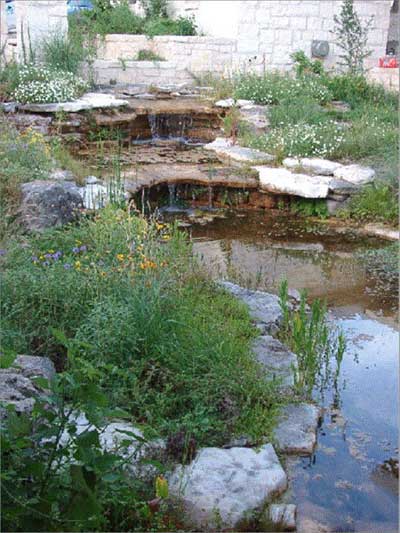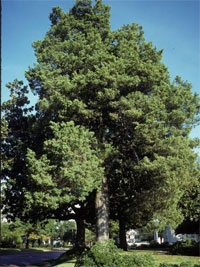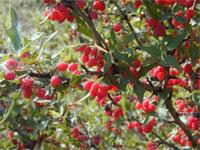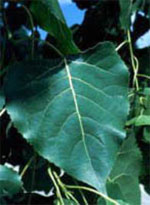Wild About Texas – August, 2009

Waterfalls. Photo by David Mahler.
Sounds of a Garden

Simple water source. Photo by Andrea DeLong-Amaya.

Eastern red cedar (Juniperus virginiana). Photo by Sally and Andy Wasowski.

Agarita berries, a favorite for birds (Mahonia trifoliolata). Photo by Joe Marcus.

Cottonwood leaves (Populus deltoids). Photo courtesy of Texas A&M.
Paramount to most garden designs is visual appeal, but what about engaging all of our senses, including the often-forgotten sense of hearing?
Water sounds appeal to most of us and foster a mood of calm. Trickles, splashes, and gurgles are the main purpose of many fountains and waterfalls, and moving water in a garden appeals to wildlife more than quiet water does, so long as it isn’t too vigorous. One of my favorite effects is the “simulated rain” of fluttering cottonwood leaves. (I believe I’ve forgotten the sound of real rain!) Other plants lend audible delights — grasses rustling in a tender breeze or whispering pines, which, in a stiff wind, can actually be more of a shout.
We are most in need of sound barriers during the bare winter months, when foliage is sparse. Dense evergreen vegetation like yaupon holly, wax myrtle, Texas mountain laurel or juniper can help isolate us from the noise pollution of roads, air conditioners, and other machinery, and also help to maximize preferred sounds.
A diversity of native fruits and seeds, shrubs for shelter, and grasses and other vegetation for nesting materials will lure an avian array to serenade us (a by-product of courtship or territorial claims). Nectar- and pollen-producing flowers engage native and European bees, which fly in with their ear-tickling and hypnotic buzzing sounds.
As much a part of summer as swimming holes, chilled watermelon or fresh beer, the entrancing drone of the cicada fuses into the oppressive heat, slowing us down and coaxing us into the folds of the nearest hammock. You do hang a hammock, don’t you? After a long afternoon nap, you may awaken to the evening cacophony of katydids, crickets, frogs and toads who have taken up residence in the lushness of your garden. You can also provide habitat for humans by encouraging intimate hang-out spaces on a porch or around a fire circle. A band of troubadours might even pitch camp should you be so lucky as to have them in the neighborhood.
Ever-popular wind chimes lend a particular character to an outdoor experience. If the tinkle of a small metal chime is “ear candy,” then the mellow rings of a well-tuned harmonic wind chime is “ear wine.” And the disposition of a wooden chime (like bamboo) is crisp, yet tranquil.
Finally, you may not need to actively introduce sound into the garden if you can appreciate what already exists. Be still and observe what your corner of the world has to offer your ears. You may notice the audible struggle of a click beetle or branches rubbing together or against a building (a situation you may want to rectify). What about the humming of faraway airplanes or that syrupy jingle of the local ice cream truck and laughing children? Ah, the sounds of summer….
About the author: Andrea DeLong-Amaya is the director of horticulture at the Lady Bird Johnson Wildflower Center in Austin.
For more information about Texas native plants, visit the Wildflower Center’s website at: www.wildflower.org.

